Intel Xeon Gold 6136 Benchmarks
For this exercise, we are using our legacy Linux-Bench scripts which help us see cross-platform “least common denominator” results we have been using for years as well as several results from our updated Linux-Bench2 scripts. At this point, our benchmarking sessions take days to run and we are generating well over a thousand data points. We are also running workloads for software companies that want to see how their software works on the latest hardware. As a result, this is a small sample of the data we are collecting and can share publicly. Our position is always that we are happy to provide some free data but we also have services to let companies run their own workloads in our lab, such as with our DemoEval service. What we do provide is an extremely controlled environment where we know every step is exactly the same and each run is done in a real-world data center, not a test bench.
We also wanted to note that our dataset is focused on pre-Spectre and Meltdown results at this point. Starting with our Ubuntu 18.04 generation of results we will have comparison points to the new reality. The Spectre and Meltdown patches to hurt Intel’s performance in many tests. At the same time, as of writing this article, patches are still being worked on. Likewise, software is being tuned to deal with the impacts of the patches. Given this, we are going to give the ecosystem some time to settle before publishing new numbers.
Python Linux 4.4.2 Kernel Compile Benchmark
This is one of the most requested benchmarks for STH over the past few years. The task was simple, we have a standard configuration file, the Linux 4.4.2 kernel from kernel.org, and make the standard auto-generated configuration utilizing every thread in the system. We are expressing results in terms of compiles per hour to make the results easier to read.
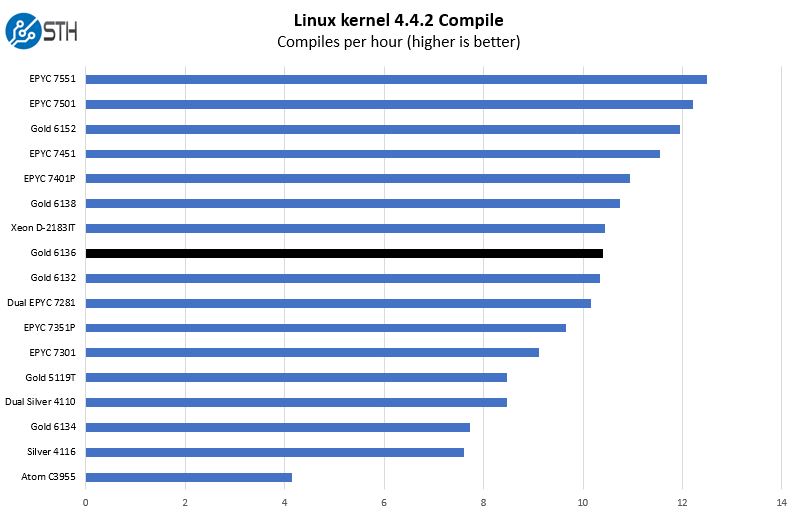
The big chasm here is between the Intel Xeon Gold 6136 and the Intel Xeon Gold 6134 and Silver 4116 CPUs. The Gold 6134 is the SKU immediately below the 6136 in the per core performance optimized stack. The Silver 4116 is the lowest cost 12-core Intel CPU of this generation. Both are handily beat by the Intel Xeon Gold 6136.
c-ray 1.1 Performance
We have been using c-ray for our performance testing for years now. It is a ray tracing benchmark that is extremely popular to show differences in processors under multi-threaded workloads. We are going to use both our legacy 4K result along with our new Linux-Bench2 8K render to show differences.
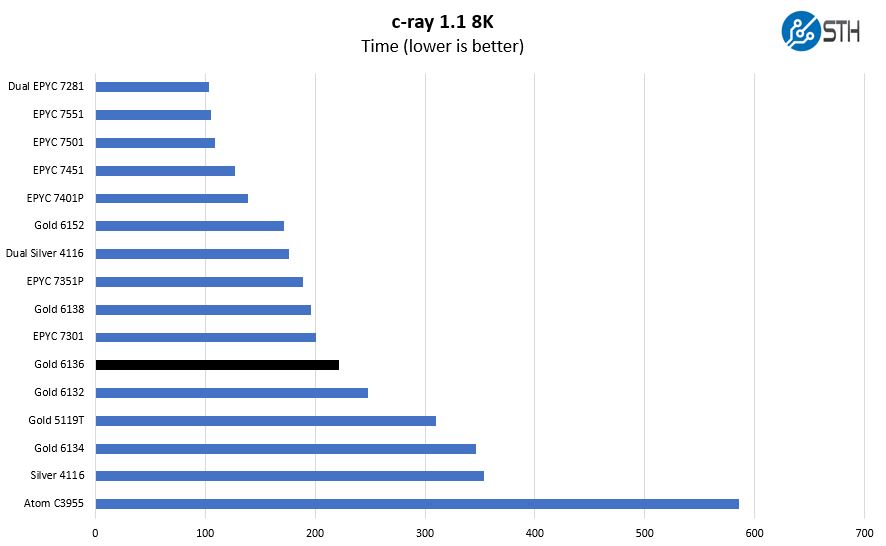
Here, even sporting more cores and the same maximum turbo frequency, the Intel Xeon Gold 6132 is not as fast as the Gold 6136. Base clocks and all core turbo clocks are important when pushing workloads across all cores.
7-zip Compression Performance
7-zip is a widely used compression/ decompression program that works cross-platform. We started using the program during our early days with Windows testing. It is now part of Linux-Bench.
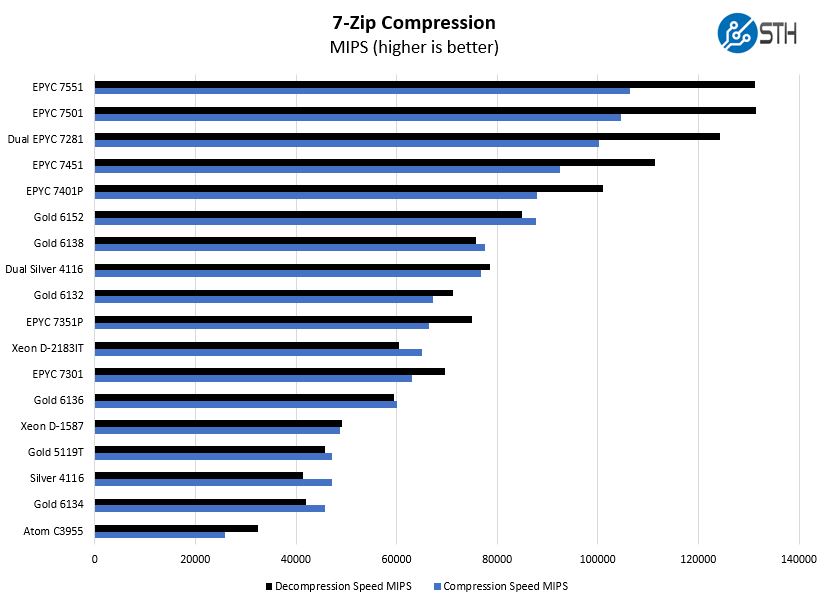
This is an example where the lack of cores hurts the Intel Xeon Gold 6136. The AMD EPYC 7301 has 16 cores and is less expensive so it performs well. On the other hand, compared to lower clocked Intel cores of the Intel Xeon D-1587, the Xeon Gold 6136 performs well.
NAMD Performance
NAMD is a molecular modeling benchmark developed by the Theoretical and Computational Biophysics Group in the Beckman Institute for Advanced Science and Technology at the University of Illinois at Urbana-Champaign. More information on the benchmark can be found here. We are going to augment this with GROMACS in the next-generation Linux-Bench in the near future. With GROMACS we have been working hard to support Intel’s Skylake AVX-512 and AVX2 supporting AMD Zen architecture. Here are the comparison results for the legacy data set:
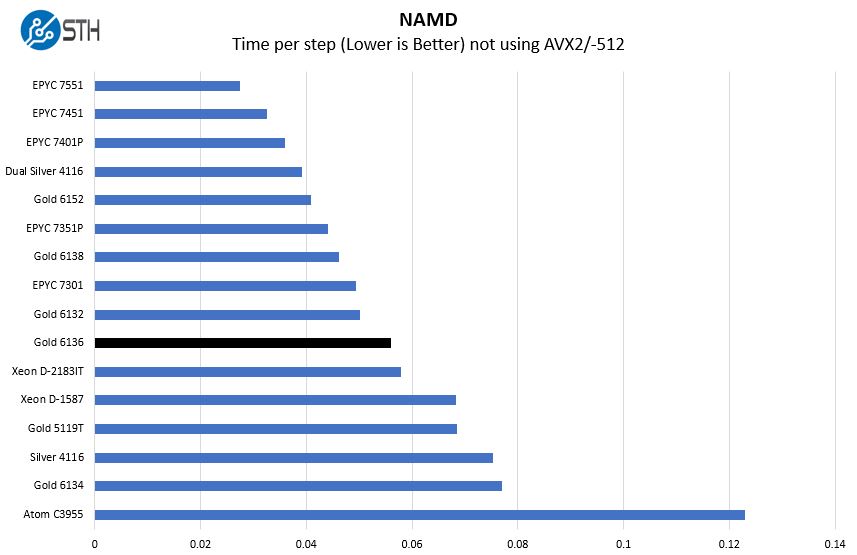
When we look at NAMD performance, we see the Intel Xeon Gold outpacing the Xeon D-2183IT 16-core part as well as the Silver 4116 and Gold 6134 by some margin.
Sysbench CPU test
Sysbench is another one of those widely used Linux benchmarks. We specifically are using the CPU test, not the OLTP test that we use for some storage testing.
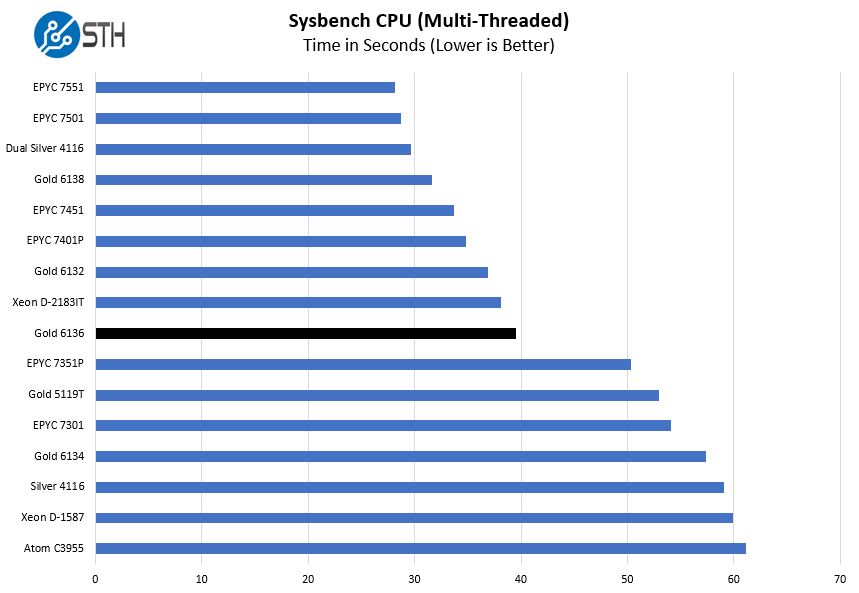
On the sysbench CPU side, we see solid performance again from the CPU. Here the Gold 6136 is able to beat 16 core AMD EPYC even with only having 12 cores.
OpenSSL Performance
OpenSSL is widely used to secure communications between servers. This is an important protocol in many server stacks. We first look at our sign tests:
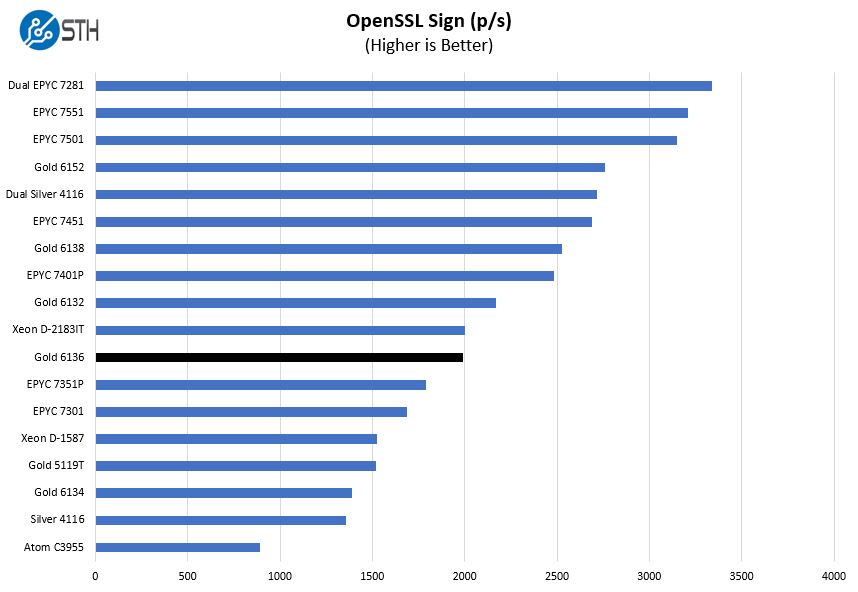
here are the verify results:
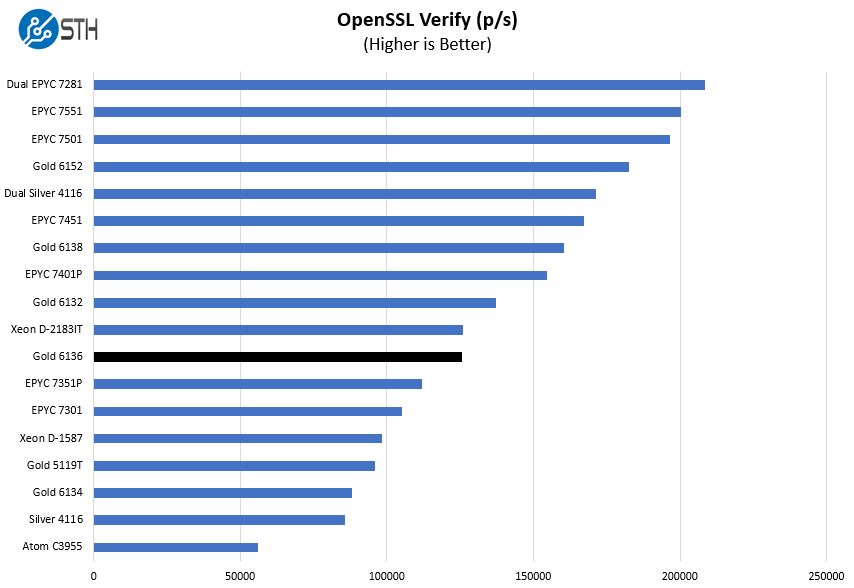
As you can see, the Intel Xeon Gold 6136 again outpaces the 16 core EPYCs and maintains pace with the Intel Xeon D-2183IT 16 core part. It is also worlds ahead of the Silver 4116 12 core part.
UnixBench Dhrystone 2 and Whetstone Benchmarks
Some of the longest-running tests at STH are the venerable UnixBench 5.1.3 Dhrystone 2 and Whetstone results. They are certainly aging, however, we constantly get requests for them, and many angry notes when we leave them out. UnixBench is widely used so we are including it in this data set. Here are the Dhrystone 2 results:
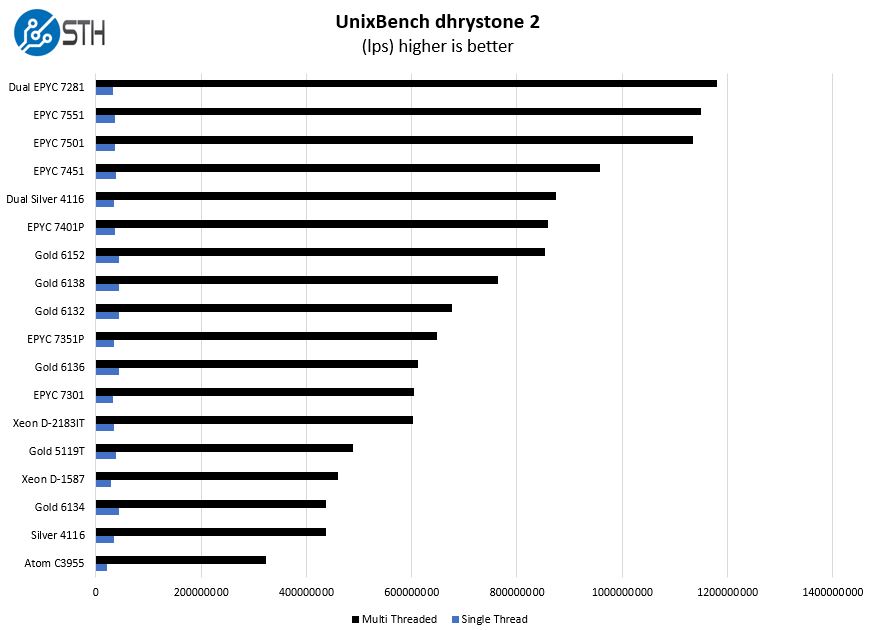
Here are the whetstone results:
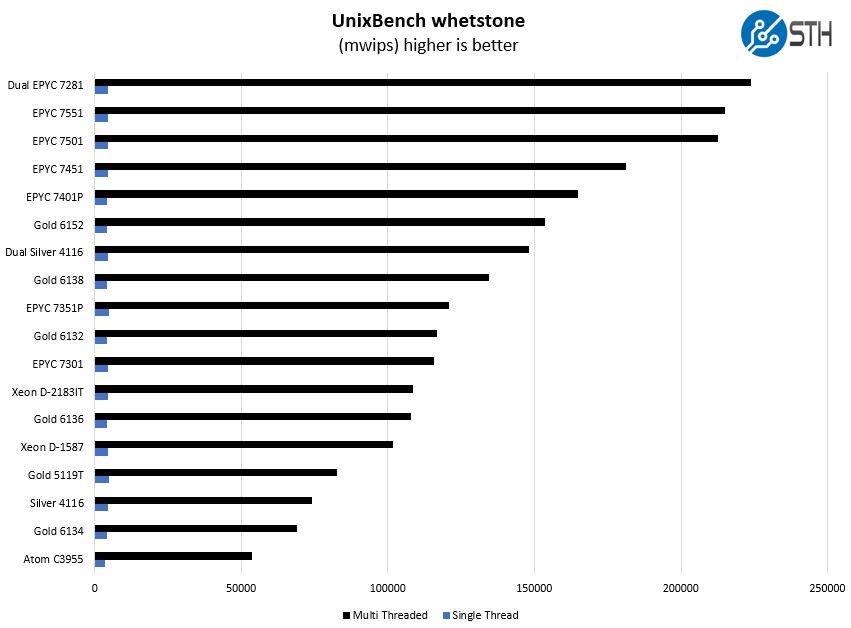
It is hard to see on this scale, but the 3.7GHz max turbo gives great single threaded performance. Here the 12 core part is competitive with lower clocked 16 core parts again.
GROMACS STH Small AVX2/ AVX-512 Enabled
We have a small GROMACS molecule simulation we previewed in the first AMD EPYC 7601 Linux benchmarks piece. In Linux-Bench2 we are using a “small” test for single and dual socket capable machines. Our medium test is more appropriate for higher-end dual and quad socket machines. Our GROMACS test will use the AVX-512 and AVX2 extensions if available.
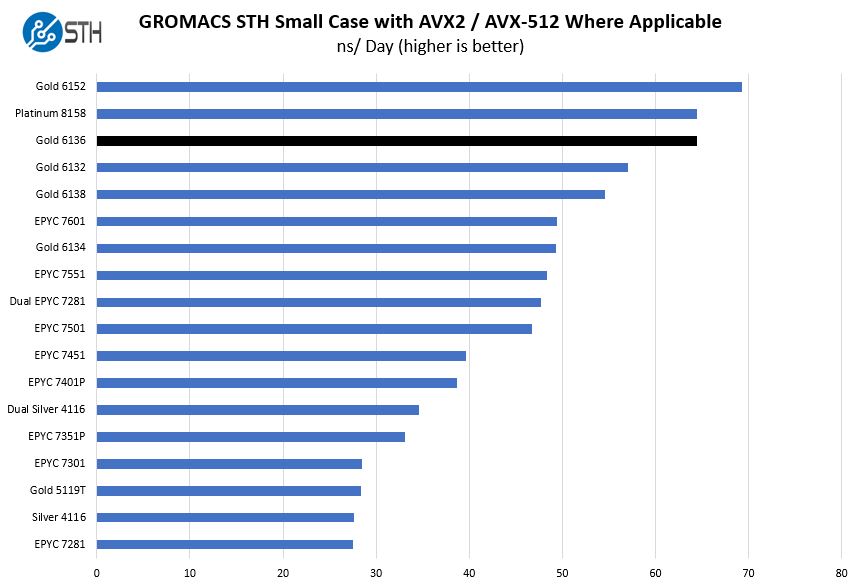
When we move to the GROMACS workload with AVX-512 enabled, we can see the Intel Xeon Gold 6136 keeping pace with the Intel Xeon Platinum 8158. Here the higher base frequency and AVX-512 frequency combined with the dual port FMA unit yields significant performance.
Chess Benchmarking
Chess is an interesting use case since it has almost unlimited complexity. Over the years, we have received a number of requests to bring back chess benchmarking. We have been profiling systems and are ready to start sharing results:
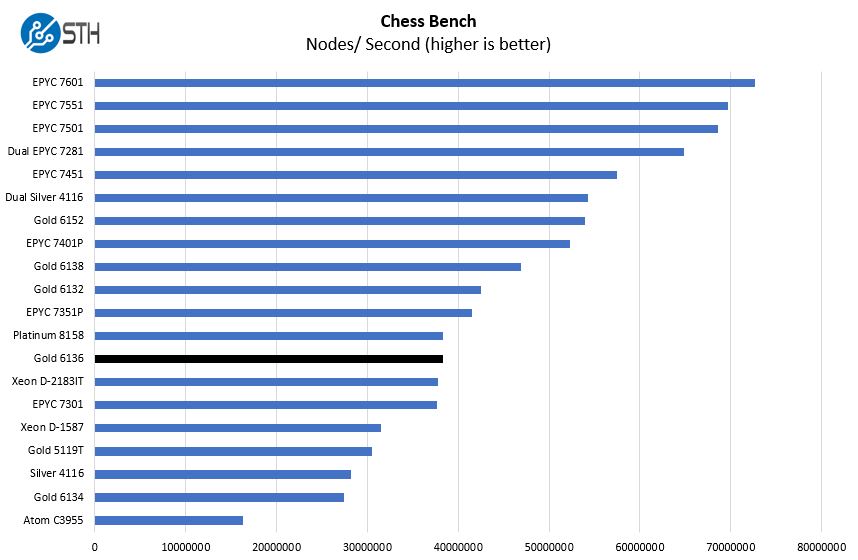
Again, we can see solid performance from the chip, however, you can see that a single Intel Xeon Gold 6138 or 6132 will provide more performance here.
Next we are going to look at the Intel Xeon Gold 6136 power consumption along with market positioning. We will then provide our concluding thoughts on the CPUs.




These look nice actually. You get more consolidation than the 6134s but you’re not adding lots of low speed cores
Any news on AMD EPYC Embedded 3000?
Hopefully will have more in the next 45 days
I use xeon 6136 with Dell R740 for Magento Shop. This is perfect.